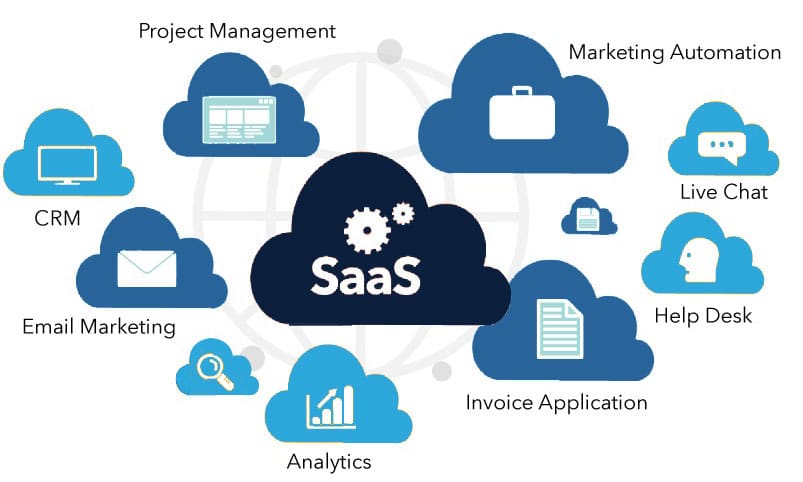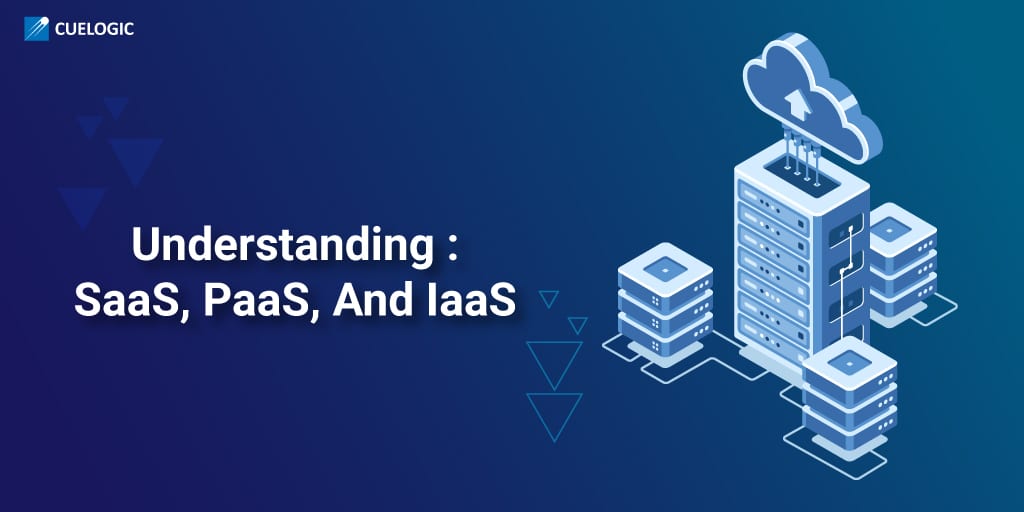Evolution of Cloud Computing Models
Over the years, this technology paradigm has evolved through multiple phases. The earlier forms of computing that preceded modern cloud computing included grid, utility, and on-demand computing. The earliest forms of modern cloud computing that include Software (SaaS), Platform (PaaS) and Infrastructure (IaaS) emerged as a technological outcome that attended the dipping costs of computer and server hardware. Users could purchase individual servers to power their computing requirements.
The cloud paradigm emerged when software makers and hardware vendors combined multiple servers in a concerted bid to harness the immense computing power generated by a grid (or network) of connected servers. Concurrently, the evolution of digital connectivity technologies that underlie the World Wide Web in recent years formally brought about the modern concept of “cloud computing.” In recent times, the purveyors of technology have parlayed cloud-computing systems into multiple tiers of service, variously labeled as SaaS, PaaS, and IaaS.
Software as a service (SaaS)
(SaaS) is a software licensing and delivery model that has gained a significant presence in a wide range of modern corporate, business, scientific, and commercial applications.

SaaS technologies allow users to license proprietary software on a subscription basis – monthly or annual. As providers of an ‘on-demand’ service, SaaS service providers host the software on the cloud to which users connect through a browser and an Internet connection. As a hugely cost-effective alternative to on-premise software installations and packages, the SaaS model seamlessly delivers a variety of applications that pertain to enterprise resource planning programs, office, and communications software, payroll and accounting packages, human resources management, mobile applications, etc.
- LOWER UP-FRONT COSTS
SaaS offers users a line of significant advantages and benefits when compared to the traditional model of installing software packages on hardware located within business premises. Lower up-front costs and zero license fees represent the main advantage. This creates distinct advantages for freshly minted business operators. For instance, SaaS services allow start-up operators to minimize the costs of bringing a business idea to life. Observers note this allows “entrepreneurs to cycle through new ideas more quickly, trying out ideas until they hit on a successful one.” This is reinforced by the fact SaaS service providers manage the information technology infrastructure that runs the software; this is the critical factor that reduces the fees for hardware and software maintenance. - HASSLE-FREE OPERATION
The nature of traditional computer systems requires expert help to configure and set up on the premises of business operators. In marked contrast, SaaS service providers install and configure SaaS applications on remote servers (known as the cloud). This difference translates into real gains for users and customers in terms of minimal delays, sustained hassle-free operation, and higher levels of engagement with the service. Also, SaaS users enjoy shorter learning curves, thereby driving higher productivity in the workplace. - AUTOMATIC UPGRADES
Software upgrades and package installation (or re-installation) can pose headaches for business operators because these consume business hours that businesses could use to find (and serve) new customers. The SaaS model removes such problems because service providers typically deploy upgrades on centrally hosted software applications. This ensures SaaS customers enjoy smooth, uninterrupted transitions to higher levels of service. Also, SaaS offers users high levels of usability and access through a browser and Internet-connected device only. This aspect promotes user convenience and decimates the traditional pain points associated with legacy computing paradigms. - SUBSCRIPTION PACKAGES
A multiplicity of choices can help elevate the appeal of service in the eyes of customers and users. Bearing this in mind, SaaS service providers offer multiple subscription packages tailored to the requirements of business users. This flexibility allows users to scale up their engagement with a SaaS service in tune with the demands of, for instance, an expanding enterprise. Customers can also negotiate with service providers to arrive at custom service packages that have individual dollar valuations. Also, customers enjoy the flexibility of operating a service on multiple devices such as desktop machines, laptop computers, connected tablets, and smartphone devices. - SaaS-POWERED LEARNING
Advancements in technology, rising use of connected mobile devices, and high levels of broadband Internet penetration are expanding the market for learning management systems that are based on SaaS technologies. Increasingly, educators and business operators are positioning learning materials, products and solutions on the cloud resulting in cost-effective learning products. These are relevant to more extensive sections of society, institutions, and organizations. Moreover, factors such as the availability of new vendors and better computational capabilities are expanding the market for SaaS-based learning products and services.
CHALLENGES with SaaS
This computing paradigm remains vulnerable to unauthorized access and malevolent hacking expeditions in online domains. Digital miscreants have targeted businesses that operate on the cloud by blocking customer access to critical online systems. This poses real risks that can translate into an erosion of market value for SaaS service providers. In response, service providers must continuously invest in improving authentication and security processes on the cloud, thereby delivering incremental assurances to their clients and customers.
Additional challenges that figure in the development of SaaS-powered products and services include custom third-party payment integration, safe and well-defined database access compliant with GDPR norms, guaranteeing zero-downtime deployment,managing the subscription lifecycle, and building a fully customizable SaaS system.
Platform as a service (PaaS)
PaaS is “a category of cloud services that provide a platform allowing customers to develop, run, and manage applications without the complexity of building and maintaining the infrastructure typically associated with developing and launching an app.”
PaaS providers host the hardware and software on their infrastructure, thereby releasing customers from any obligation to install in-house hardware and software to develop or run a new application.

- LOWER SET-UP COSTS
For instance, a major commercial vendor such as Oracle offers Oracle Platform Services to modern software developers. Subscription-based models that allow developers to build Java applications, mobile apps, and websites drive access to these services. This cloud-computing model is gaining steam because it helps customers to reduce their set-up costs and cut the expenses associated with maintenance. - ASSET FOR CODERS
PaaS-based systems allow developers to retain significant levels of control over custom configurations, thereby preserving the contours (and content) of original development work. Developers are empowered by the fact PaaS service providers handle application execution services, data services, and the underlying operating system functions. Besides, high-grade PaaS vendors offer developers the use of individual development tools, frameworks, and other resources uniquely tuned and configured for use in the platform provided by the vendor(s). - SCALE AT WILL
Scalability remains one of the watchwords of the platform as a service. PaaS services are typically scalable that generate substantial cost savings for developers, thereby aiding revenue generation mechanisms to gain greater traction. The real world benefits for developers include the ability to expand the scope of an application in tune with market requirements. - SPECIAL EDITIONS
PaaS service providers deliver enterprise versions of custom services to customers through a hybrid model that incorporates public clouds, and on-premise compute infrastructure. However, some clients prefer to use purely special versions of PaaS. These choices serve to boost developers’ productivity, enhance their utilization rates, and lower an application’s time to market cycle. - BELLS & WHISTLES
The applications developed from the ground up using PaaS technologies offer scalability, SaaS enablement, can accommodate multiple digital tenants; provide 99% uptime, etc. Observers note that enterprises deploy PaaS technologies primarily because these reduce the amount of coding required to enable an cloud application, help to automate business policy and drive the migration of apps to the hybrid model of cloud computing.
Challenges with PaaS
PaaS technologies pose particular problems and risks for service providers. These challenges include balancing control, cost, and capacity of a PaaS-based service, providing full multi-tenancy support, designing role-based access controls, creating audit trails, and integrating third-party services into modern PaaS platforms. Additional challenges may emerge in the form of virtualization management, fine-tuning the PaaS compute architecture, designing inter-operability with other cloud services, and creating technically sound fault tolerance parameters.
Infrastructure as a Service (IaaS)
IaaS operates by traditional cloud architecture. Per the IaaS cloud-computing paradigm, service providers host the infrastructure such as servers, storage units, networking hardware, virtualization or hypervisor layer, etc. This model negates the legacy business case for investing in on-premise data center infrastructure and equipment. Modern IaaS service providers also offer policy-driven services to clients and customers. These services include monitor service performance, detailed billing of customer services, log access, digital security, load balancing, backup, replication, and recovery, etc.

IaaS represents “the virtual delivery of computing resources in the form of hardware, networking, and storage services. It may also include the delivery of operating systems and virtualization technology to manage the resources. Rather than buying and installing the required resources in their own data center, companies rent these resources as needed,” according to popular definitions of IaaS.
- COST-EFFICIENCYThe infrastructure-as-a-service paradigm offers a cost-efficient computing paradigm for users and customers. Most IaaS customers pay service providers on a per-user basis or may negotiate hourly, weekly, or monthly rates. Observers note the pay-as-you-go model eliminates significant capital investments and the up-front costs incurred when business operators deploy legacy versions of on-premise hardware and software packages.
- BRANDED SERVICES
Some of the stalwart instances of IaaS vendors and products include Amazon Web Services (AWS), which offers Simple Storage Services (S3) and Glacier. AWS also offers customers the use of computer services such as Elastic Compute Cloud (EC2). Similar products spring from Google Cloud Platform (GCP) that provides storage and compute functions through Google Compute Engine (GCE). - LOW TO HIGH
IaaS providers often implement a tiered approach to pricing for their services and products. This helps them attract a broad swathe of customers with differing requirements and gain traction in competitive commercial markets for cloud computing services. Amazon Web Services, for instance, allows enterprise customers to access AWS Spot Instance at sharply discounted prices compared to its menu of on-demand services. Similarly, users can access specific versions of Google’s virtual machines at rates that are 70% lower than its superior virtual machine services. These instances of dynamic pricing are an outcome of service providers’ imperative to offload spare computing capacity to interested customers. - SUPER PROSPECTS
The commercial market for IaaS services is expected to expand at a brisk pace shortly. Industry observers remain upbeat in light of rising demand for (and growing adoption of) infrastructure computer functions in the enterprise market. Significant drivers of these trends include pure-play IaaS service providers and cloud optimization services providers related closely to telecom services. Meanwhile, “Midmarket and small enterprises are even further along the adoption curve. By 2019, more than 30% of the 100 largest vendors’ new software investments will have shifted from cloud-first to cloud-only,” according to a recent press release by Gartner.
CHALLENGES of IaaS
A raft of business challenges have emerged to face service providers that offer IaaS services to clients and customers. These may include subscriber expectation management, defining support systems that handle different forms of payments from customers, accommodating the need for custom analytics that measures customer profitability and usage, managing the service value chain, and controlling business with multiple partners. Also, service operators must remain agile in terms of experimenting with product prices, product features, the configuration of service packages, and navigating the intricacies of customer licenses. They must also work to actively manage customer expectations and refine the concept of datacentre ‘in-the-sky.’
Conclusion
The business case for cloud computing technologies and frameworks will continue to burnish its relevance and utility years and decades into the future. The large and incrementally enormous volumes of data generated by modern scientific, commercial, and technological enterprises will require larger data centers powered by innovative technologies. These may form the central planks of local, regional, and national economies in the future. That said, the central role of the cloud may morph into differentiated expressions, marshaled by real-time processing technologies and a deeper engagement with refined versions of civilizational requirements.
